Carving out New Business Models in a Small Company through Contextual Ambidexterity: The Case of a Sustainable Company
Abstract
1. Introduction
2. Theoretical Background
2.1. Business Models and Sustainability
2.2. What Characterize a Business Model Innovation?
2.3. Organizational Ambidexterity
- Sequential Ambidexterity: it is characterized by the companies’ evolution, adapting to environmental changes by realigning their structures and processes sequentially [59]. That is, a company would go from the condition of exploiting to exploring, and vice-versa, at specific periods of time. Extending to the context of BMI, an organization with sequential ambidexterity would identify a problem in its current BM and explore a possible new BM. Then, it would manage more than one BM at the same time and, when the new BM is at the point of escalation, steadily move from the previous to the next BM, dropping the first after the novel is successful. For this reason, sequential ambidexterity studies often focus on long-term examples.
- Simultaneous or structural ambidexterity: this approach usually separates the company into two different structures, which could differ not only structurally but also in competencies, systems, incentives, process, and culture [56]. Each distinct unit has its own purpose. Hence the idea of simultaneity: while the company allocates part of its resources for exploitation, it keeps another part simultaneously for exploration. In terms of BM, the company would manage to exploit and exploring more than one BM at the same time. They could be seen as two different companies, whenever there is also structural separation [23].
- Contextual Ambidexterity: both types of ambidexterity presented above face the challenge of exploring and exploiting at the organizational level. Gibson and Birkinshaw [54] propose an approach at the individual level—characterized by starting from the individuals of the company—depending on the context presented. This approach is defined as the behavioral ability to simultaneously demonstrate alignment and adaptability in a single business unit [54]. This approach argues individuals in a company make their own judgment on how to best divide their time to meet demands for alignment and adaptability. From the BM context, the company would manage more than one BM at the same time. However, unlike the structural approach, there would be no structural separation between them. Therefore, usually, the same people are responsible for the different BM, having to shift from one activity to another.
2.4. BMI Mechanisms and Sustainability
3. Method
3.1. Research Methodology
3.2. Research Design
- First step: Understand the problem and the class of problems based on practical observation and theoretical considerations. The main focus is to understand the existing and unsolved problem in practice that also lacks theory as to how to overcome it in practice [73].
- Second step: build the artifact based on the extant literature and by taking into consideration existing frameworks and methods. This is a literature analysis especially focused on building the artifact for solving the identified problem. Thus, it should not be confused with a literature review used to build an article since they have different inputs and different goals [72].
- Third step: evaluate the artifact using naturalistic and/or artificial evaluations. The former refers to real-world applications, using testing case studies or action research, whereas the latter involves simulation models or experimental settings. As justified above, in this study we followed a naturalistic approach.
- Fourth step: derive conclusions and generate discussion for knowledge creation around the class of problem and the artifact. It is a reflective step once the focus is to better understand the artifact functioning and also take into consideration consequences not previously expected due to the close relation to practical context [72].
3.3. Class of Problem
3.4. Naturalistic Evaluation Data Collection and Analysis
3.4.1. Case Selection
3.4.2. Data Collection and Analysis
4. Building the Artifact—Combining Business Models Innovation Schools
4.1. Adapting the Exploitation Environment
- We provide a practical application for the relationship between strategy and BMI.
- Considering this relationship, we integrated several traditional strategic management tools into the BMI notion, lapidating to the SME context to search for the operationalization of BMI through tactical actions.
- The approach builds on performance management, which confers guidance for the decision-making process based on data, with the sight of continually improving the BM.
- We discussed the impact of tactical actions on BM, highlighting that this analysis is dependent upon the selected method for representing and communicating the BM.
4.2. Creating the Exploration Environment
- Target Customer: represents the customers that the company intends to serve with the BM. These are real customers who have needs that are still to be met, which Johnson [48] calls the “job to be done”.
- Job-to-be-done: it is a problem or a need that certain target customers have, but is still not fulfilled or poorly fulfilled. Hilti’s case is a good illustration. The company initially sold construction tools for its customers. Nevertheless, Hilti realized that its customers did not need to own the tools to finish and deliver the construction to its customers, only creating unnecessary costs. Thus, by selling the tools, Hilti left a job-to-be-done still poorly fulfilled, because the CVP was to provide the right tools at the right time for its customers. The company then changed to lend the needed tools by demand, charging by use, and, therefore, better fulfilling the job-to-be-done [48].
- Offering: Once the problem is identified, or the need is important, it is necessary to offer a solution that will remedy the job to be done.
- The organization and integration of different startups and new venture creation literature, considering each tool specificity.
- The emphasis on using the project management approach to exploratory BMI, securing the creation of knowledge assets and avoiding high investments in the initial phases of the flow.
- The focus on reducing necessary investment, while also looking for improving current business, which we believe can provide a potential means for SMEs top management team to embrace ambidexterity.
4.3. Knowledge Management as the Connection between Environments
- The artifact not only provides exploitation and exploration structures but also promotes the operationalization of both in tandem.
- The understanding that leveraging the created knowledge in both environments, through KM, can be the key to contextual ambidexterity’s success.
5. Artifact Evaluation—Case Study
5.1. The Selected Company Current Business Model
5.2. Exploitation Environment
5.3. Exploration Environment
- Key activities:
- ⚬
- Product development (on demand): unlike what happens in the e-commerce BM, the company will only produce on-demand and the orders are subject to customer wishes. However, even now starting from the initial briefing provided by customers, it will be necessary to develop the concept of the product also on demand. Thus, the competencies regarding product and supplier development are also important. Nevertheless, some adaptation will be necessary to adapt the company to work on demand.
- ⚬
- Supplier development: this element will also be important and is an important synergy between the two BM. In the other BM, there is certain flexibility since supplier failures often resulted in delaying a new collection launch, which is something internally manageable by the company. In this corporate gifts BM, however, delays will affect one of the value propositions: the reliability in delivering demand.
- Value proposition:
- ⚬
- Sustainable and with high-quality gifts: this value proposition concerns the level of quality with which the gifts will be delivered. As noted throughout the development of the exploration environment, this proposition is one of the differentials of the company to operate in this field. For this reason, it is essential that this value proposition is brought to its target customers.
- ⚬
- Reliability on-demand delivery: this BM aims to serve the event agencies, but they will have large corporations as end customers, who demand not only quality in the delivery of gifts, but also have a very low degree of flexibility with respect to deadlines.
- Channels:
- ⚬
- E-mail and telephone: the experimentation of the company’s offers in this first hypothetical BM study was carried out only via electronic mail and telephone calls. However, it is necessary to expand these channels in new tests, so that it is possible to reach a larger volume of potential customers.
- Customer segments:
- ⚬
- Event agencies: the event agencies were the only of the contacted customer segments that offered the possib–ility of testing the new BM in this initial study. This does not necessarily mean that others are discarded.
- Revenue stream:
- ⚬
- Batch sale: unlike the e-commerce BM that makes its sales in the form of retail, these BM revenues come from the sale of the total demanded production batch.
5.4. Knowledge Management
6. Discussion
7. Conclusion
Author Contributions
Funding
Conflicts of Interest
Appendix A. The Exploitation Environment
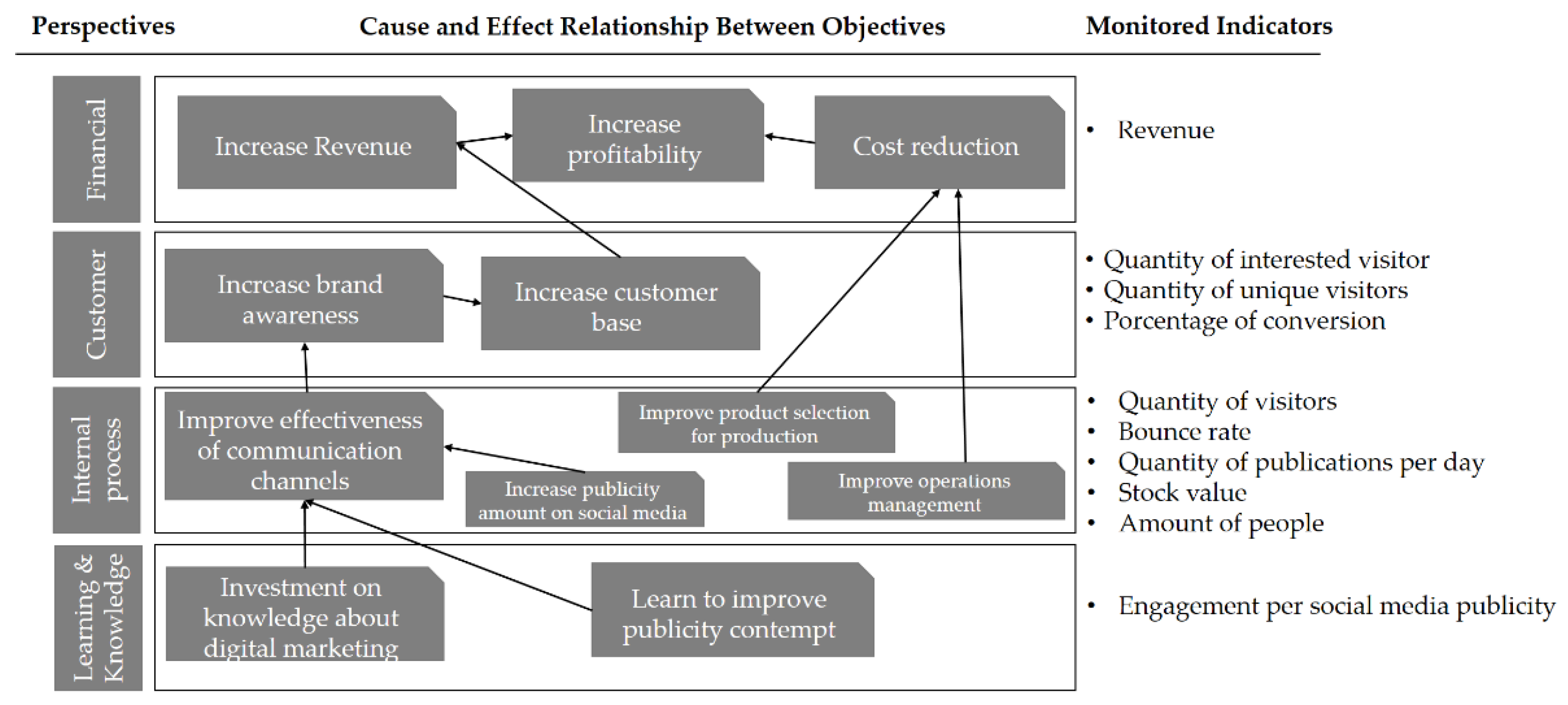
| Objective | Tactical Action | Description | Effect |
|---|---|---|---|
| Increase the volume of publications | Creation of a social media publications agenda. | The purpose of this action was to make the company’s publications on social networks more frequent and regular. | The progressive increase in posts over the last quarter of 2016, started to accompany the growth of indicators, as shown in Figure A2. As shown in Figure A4, there was an increase in the number of users after the implementation of this tactical action. There was also a change in the users’ access platform. Analyzing the devices used to access the e-commerce, it was noted that, while new users from mobile platforms grew, their conversion rate did not. At the same time, on the other hand, the conversion of desktop users grew. One possible explanation for this situation is that e-commerce was not optimized for mobile access. |
| Improving the effectiveness of communication channels | Partnerships with social media influencers | The purpose was to pursue partnerships through permutations, that is, the company provided products to influencers, in exchange for producing publications promoting the product. | There was a greater control of the rejection rate, while access to e-commerce through social media grew, as shown in Figure A3. |
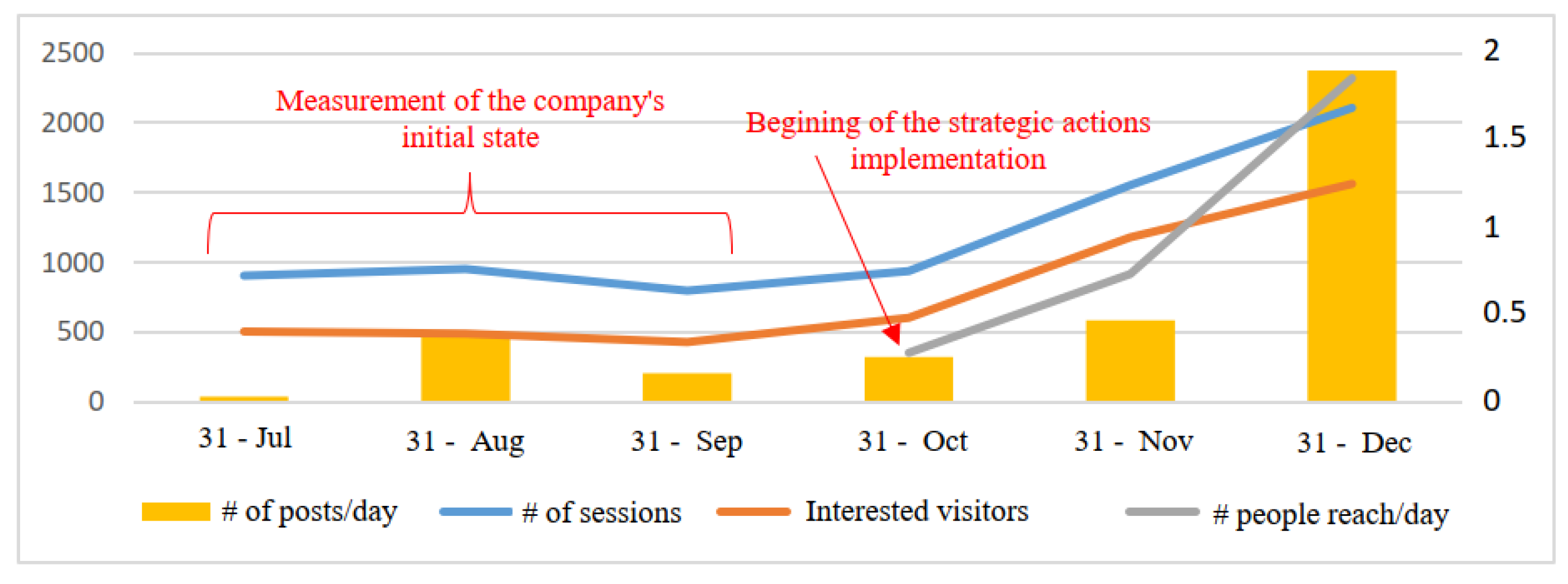


Appendix B. The Exploration Environment
| Hypothesis about CVP | Description | Decision |
|---|---|---|
| Business model to serve wholesale groups | The company members discussed the possibility of developing a business model to serve wholesale groups, keeping their vegan production process, striving for sustainability. | The company did not feel safe to explore this opportunity. It was argued that it would be a big step, to deal with a large volume of production. |
| Business model within the concept of Circular Economy (CE) | The company raised the opportunity to seek a business model within the concept of Circular Economy (CE). CE is a recent concept in the literature related to sustainability, where the aim is a closed loop, eliminating all resource inputs and waste of the system [132]. CE requires the adoption of new business models, beyond the principles of “reduce, reuse and recycle” [133]. | The company’s idea would be to replace its input resources with used clothes, to recreate products, changing its production process. However, again the company didn’t feel safe to implement this change, arguing that they were not prepared for creating a new production process. |
| Business model for manufacturing and trading corporate gifts | Based on the founder’s experience, who had already participated in many corporate events, there was an idea that the available products for sewn corporate gifts had low quality and were not sustainable-oriented. The founder argued that joining these corporate events, and communicating with people playing in this market, showed her that there could be a job to be done here. | The company decided to explore this new business model. Some potential target customers were established. The company used the empathy map tool to understand the context of these customers. Often used by Stanford University in its design institute [134], it is a visual tool for organizing information about the potential customers and create their personas. The first version of this tool was adapted, and as an example, the persona named event agency will be demonstrated in Figure A5, based on the founder’s knowledge about this type of persona. |
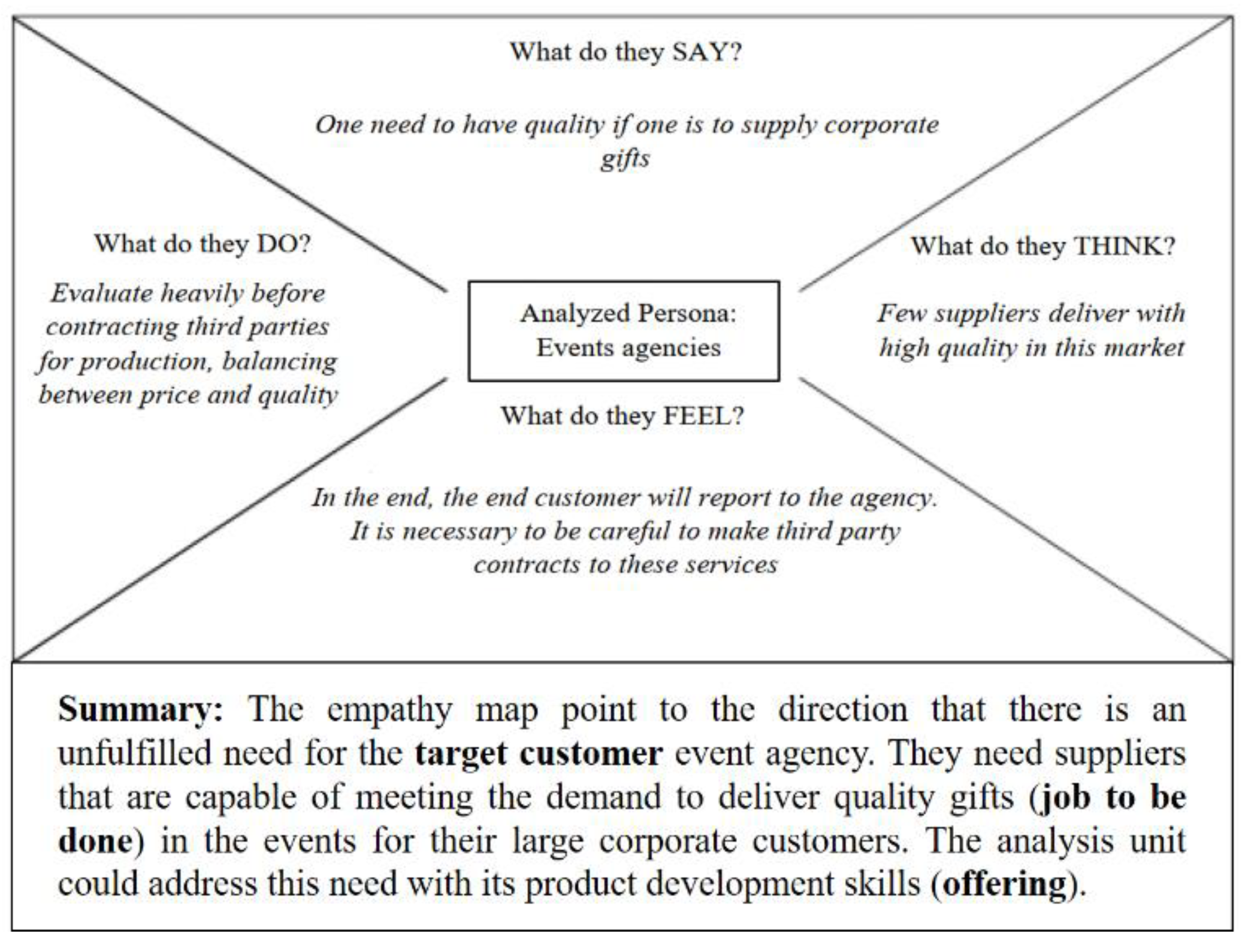
| Company Type | |||||
|---|---|---|---|---|---|
| Consultancy Firms | Events Agencies | Exchange and Travel Agencies | Gym | Language Schools | |
| Contacted companies | 16 | 96 | 31 | 27 | 22 |
| Contacted companies that work with gifts: Considering the companies that would be contacted, which ones offered gifts to their customers? Some companies to strengthen their relationship with their customers offer free gifts. Others, however, hold corporate events where they provide their guests and participants with souvenirs of the occasion. | 3 | 53 | 18 | 11 | 9 |
| Companies that have demand for gifts: That is, is there a demand for this type of offer, in the case of the elaboration of a business model aiming to meet this type of market need? | 1 | 16 | 5 | 4 | 3 |
| Companies with an interest in knowing the value proposition: Important to note the real need to have such a supplier in the market. It would be the case that there is already a supplier, or that the market is already satisfied with the offers they have at the moment. | 0 | 6 | 3 | 1 | 1 |
| Gift production request: The founder made a presentation and sent it to the interested companies. As a result, some meetings were scheduled, and the founder had the opportunity to better demonstrate the offering. A few weeks later, one of the contacted companies, an event agency, requested a gift production for an event demanded by a large multinational in the technology industry. With that, it was noted that a hypothetical new business model could be designed, to be managed in parallel to the current one. Thus, as demonstrated in the construction of the artifact, a project orientation was adopted. This initial demand made by the event’s agency, was for a batch of a standardized sewn cell phone holder as shown in Figure A6. The demand was for 400 pieces of this product, which would be distributed to guests at the multinational’s event. | 0 | 1 | 0 | 0 | 0 |
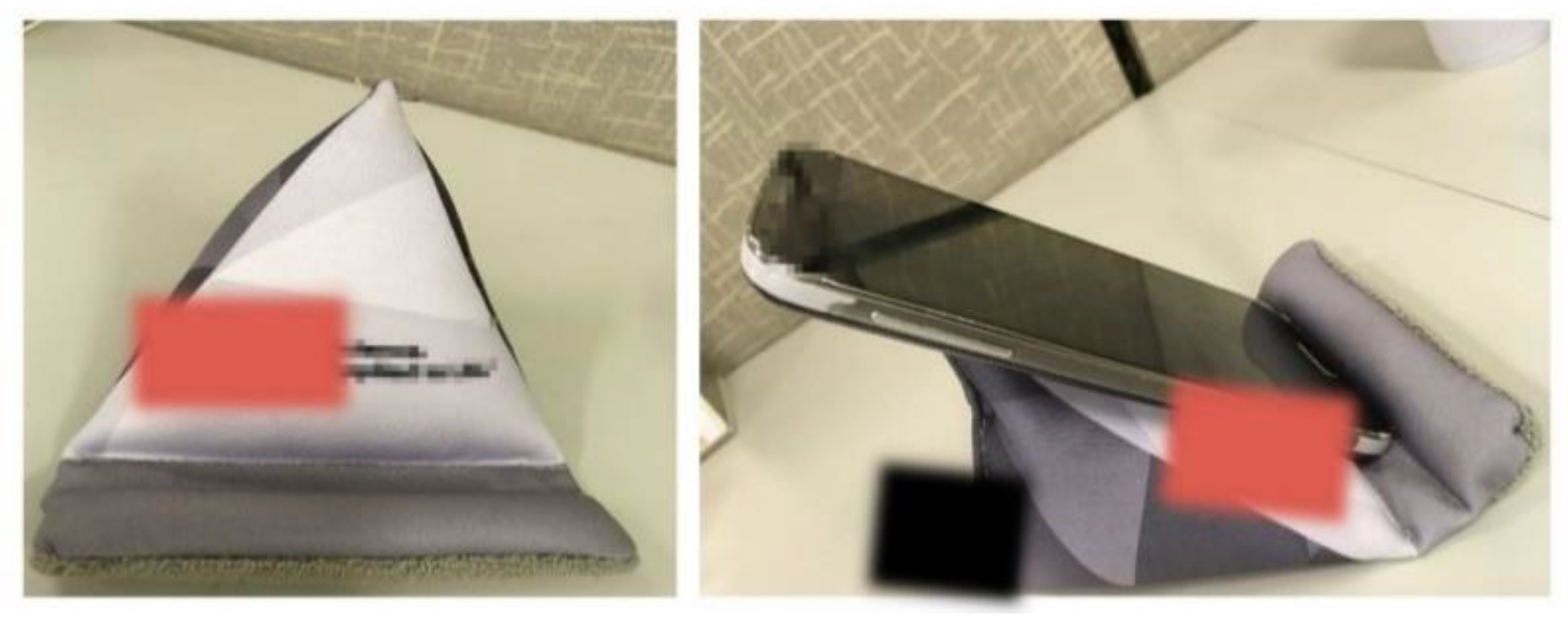
References
- Schaltegger, S.; Lüdeke-Freund, F. Business Cases for Sustainability. In Encyclopedia of Corporate Social Responsibility; Idowu, S., Capaldi, N., Zu, L., Das Gupta, A., Eds.; Springer: Berlin/Heidelberg, Germany, 2013; pp. 245–252. ISBN 978-3-642-28035-1. [Google Scholar]
- Jolink, A.; Niesten, E. Sustainable Development and Business Models of Entrepreneurs in the Organic Food Industry. Bus. Strateg. Environ. 2015, 24, 386–401. [Google Scholar] [CrossRef]
- Frankenberger, K.; Weiblen, T.; Csik, M.; Gassmann, O. The 4I-framework of business model innovation: A structured view on process phases and challenges. Int. J. Prod. Dev. 2013, 18, 249. [Google Scholar] [CrossRef]
- Laudien, S.M.; Daxböck, B. Business model innovation processes of average market players: A qualitative-empirical analysis. R&D Manag. 2017, 47, 420–430. [Google Scholar]
- Täuscher, K.; Abdelkafi, N. Visual tools for business model innovation: Recommendations from a cognitive perspective. Creat. Innov. Manag. 2017, 26, 160–174. [Google Scholar] [CrossRef]
- von den Eichen, S.F.; Freiling, J.; Matzler, K. Why business model innovations fail. J. Bus. Strategy 2015, 36, 29–38. [Google Scholar] [CrossRef]
- Bouncken, R.B.; Fredrich, V. Business model innovation in alliances: Successful configurations. J. Bus. Res. 2016, 69, 3584–3590. [Google Scholar] [CrossRef]
- Huang, H.C.; Lai, M.C.; Lin, L.H.; Chen, C.T. Overcoming organizational inertia to strengthen business model innovation: An open innovation perspective. J. Organ. Chang. Manag. 2013, 26, 977–1002. [Google Scholar] [CrossRef]
- Winterhalter, S.; Weiblen, T.; Wecht, C.H.; Gassmann, O. Business model innovation processes in large corporations: Insights from BASF. J. Bus. Strategy 2017, 38, 62–75. [Google Scholar] [CrossRef]
- Mezger, F. Toward a capability-based conceptualization of business model innovation: Insights from an explorative study. R&D Manag. 2014, 44, 429–449. [Google Scholar]
- Kesting, P.; Günzel-Jensen, F. SMEs and new ventures need business model sophistication. Bus. Horiz. 2015, 58, 285–293. [Google Scholar] [CrossRef]
- Anwar, M. Business Model Innovation and SMEs Performance—Does Competitive ADdvantage Mediate? Int. J. Innov. Manag. 2018, 22, 1850057. [Google Scholar] [CrossRef]
- Lindgardt, Z.; Reeves, M.; Stalk, G.; Deimler, M.S. Business Model Innovation: When the game gets tough, change the game. In Own the Future; John Wiley and Sons: Hoboken, NJ, USA, 2012; pp. 291–298. [Google Scholar]
- WCED. Our Common Future: From One Earth to One World; Oxford University Press: New York, NY, USA, 1987. [Google Scholar]
- Adams, R.; Jeanrenaud, S.; Bessant, J.; Denyer, D.; Overy, P. Sustainability-oriented Innovation: A Systematic Review. Int. J. Manag. Rev. 2016, 18, 180–205. [Google Scholar] [CrossRef]
- Stubbs, W.; Cocklin, C. Conceptualizing a “Sustainability Business Model”. Organ. Environ. 2008, 21, 103–127. [Google Scholar] [CrossRef]
- Fontana, R.M.; Meyer, V.; Reinehr, S.; Malucelli, A. Management Ambidexterity: A Clue for Maturing in Agile Software Development. In Proceedings of the International Conference on Agile Software Development, Helsinki, Finland, 25–29 May 2015; Lassenius, C., Dingsøyr, T., Paasivaara, M., Eds.; Springer International Publishing: Cham, Switzerland, 2015; pp. 199–204. [Google Scholar]
- Simon, M.S. Organizational Ambidexterity: Welcome to Paradox City. Hum. Resour. Manag. Int. Dig. 2017, 25, 1–3. [Google Scholar]
- Michelino, F.; Cammarano, A.; Celone, A.; Caputo, M. The linkage between sustainability and innovation performance in IT hardware sector. Sustainability 2019, 11, 4275. [Google Scholar] [CrossRef]
- Lee, M.T.; Raschke, R.L. Innovative sustainability and stakeholders’ shared understanding: The secret sauce to “performance with a purpose”. J. Bus. Res. 2020, 108, 20–28. [Google Scholar] [CrossRef]
- Katic, M.; Cetindamar, D.; Agarwal, R.; Sick, N. Operationalising Ambidexterity: The Role of “Better” Management Practices in High-Variety, Low-Volume Manufacturing. In Proceedings of the 2019 Portland International Conference on Management of Engineering and Technology (PICMET), Portland, OR, USA, 25–29 August 2019; pp. 1–8. [Google Scholar]
- Colclough, S.N.; Moen, Ø.; Hovd, N.S.; Chan, A. SME innovation orientation: Evidence from Norwegian exporting SMEs. Int. Small Bus. J. Res. Entrep. 2019, 37, 780–803. [Google Scholar] [CrossRef]
- Markides, C.C. Business Model Innovation: What can the ambidexterity literature teach us? Acad. Manag. Perspect. 2014, 27, 1–358. [Google Scholar] [CrossRef]
- Child, J.; Hsieh, L.; Elbanna, S.; Karmowska, J.; Marinova, S.; Puthusserry, P.; Tsai, T.; Narooz, R.; Zhang, Y. SME international business models: The role of context and experience. J. World Bus. 2017, 52, 664–679. [Google Scholar] [CrossRef]
- Chang, Y.Y.; Hughes, M. Drivers of innovation ambidexterity in small- to medium-sized firms. Eur. Manag. J. 2012, 30, 1–17. [Google Scholar] [CrossRef]
- Schneider, S.; Spieth, P. Business Model Innovation: Towards an Integrated Future Research Agenda. Int. J. Innov. Manag. 2013, 17, 1340001. [Google Scholar] [CrossRef]
- Cole, R.; Purao, S.; Rossi, M.; Sein, M.K. Being proactive: Where action research meets design research. In Proceedings of the International Conference on Information Systems, Las Vegas, NV, USA, 11–14 December 2005; pp. 325–336. [Google Scholar]
- Foss, N.J.; Saebi, T. Fifteen Years of Research on Business Model Innovation: How Far Have We Come, and Where Should We Go? J. Manag. 2016, 43, 200–227. [Google Scholar] [CrossRef]
- Magretta, J. Why Business models matter. Harv. Bus. Rev. 2002, 982, 3–8. [Google Scholar]
- Shafer, S.M.; Smith, H.J.; Linder, J.C. The power of business models. Bus. Horiz. 2005, 48, 199–207. [Google Scholar] [CrossRef]
- Teece, D.J. Profiting from innovation in the digital economy: Enabling technologies, standards, and licensing models in the wireless world. Res. Policy 2018, 47, 1367–1387. [Google Scholar] [CrossRef]
- Teece, D.J. Business models, business strategy and innovation. Long Range Plan. 2010, 43, 172–194. [Google Scholar] [CrossRef]
- DaSilva, C.M.; Trkman, P. Business model: What it is and what it is not. Long Range Plan. 2014, 47, 379–389. [Google Scholar] [CrossRef]
- Barney, J.; Wright, M.; Ketchen, D.J. The resource-based view of the firm: Ten years after 1991. J. Manag. 2001, 27, 625–641. [Google Scholar] [CrossRef]
- Foss, N.J.; Saebi, T. Business models and business model innovation: Between wicked and paradigmatic problems. Long Range Plan. 2018, 51, 1–13. [Google Scholar] [CrossRef]
- Adams, R.; Bessant, J.; Phelps, R. Innovation management measurement: A review. Int. J. Manag. Rev. 2006, 8, 21–47. [Google Scholar] [CrossRef]
- Baregheh, A.; Rowley, J.; Sambrook, S. Towards a multidisciplinary definition of innovation. Manag. Decis. 2009, 47, 1323–1339. [Google Scholar] [CrossRef]
- Linton, J.D. De-babelizing the language of innovation. Technovation 2009, 29, 729–737. [Google Scholar] [CrossRef]
- OECD; EUROSTAT. Oslo Manual 2018: Guidelines for Collecting, Reporting and Using Data on Innovation, 4th ed.; The Measurement of Scientific, Technological and Innovation Activities, OECD Publishing: Paris, France; Eurostat: Luxembourg, 2018; ISBN 9789264304550. [Google Scholar]
- Casadesus-Masanell, R.; Ricart, J.E. From strategy to business models and onto tactics. Long Range Plan. 2010, 43, 195–215. [Google Scholar] [CrossRef]
- Achtenhagen, L.; Melin, L.; Naldi, L. Dynamics of Business Models—Strategizing, Critical Capabilities and Activities for Sustained Value Creation. Long Range Plan. 2013, 46, 427–442. [Google Scholar] [CrossRef]
- Khanagha, S.; Volberda, H.; Oshri, I. Business model renewal and ambidexterity: Structural alteration and strategy formation process during transition to a Cloud business model. R&D Manag. 2014, 44, 322–340. [Google Scholar]
- Eppler, M.J.; Hoffmann, F. Strategies for Business Model Innovation: Challenges and Visual Solutions for Strategic Business Model Innovation. In Strategy and Communication for Innovation; Pfeffermann, N., Minshall, T., Mortara, L., Eds.; Springer: Berlin/Heidelberg, Germany, 2013; pp. 3–14. ISBN 978-3-642-41479-4. [Google Scholar]
- Zott, C.; Amit, R. The fit between product market strategy and business model: Implications for firm performance. Strateg. Manag. J. 2008, 29, 1–26. [Google Scholar] [CrossRef]
- Chesbrough, H.; Rosenbloom, R.S. The role of the business model in capturing value from innovation: Evidence from Xerox Corporation ’ s technology spin-off companies. Ind. Corp. Chang. 2002, 11, 529–555. [Google Scholar] [CrossRef]
- Minatogawa, V.L.F.; Franco, M.M.V.; Rampasso, I.S.; Anholon, R.; Quadros, R.; Durán, O.; Batocchio, A. Operationalizing Business Model Innovation through Big Data Analytics for Sustainable Organizations. Sustainability 2019, 12, 277. [Google Scholar] [CrossRef]
- Zott, C.; Amit, R. Business Model Innovation. In The Oxford Handbook of Creativity, Innovation, and Entrepreneurship; Shalley, C.E., Hitt, M.A., Zhou, J., Eds.; Oxford University Press: New York, NY, USA, 2015. [Google Scholar]
- Johnson, M.W. Seizing the White Space: Business Model Innovation for Growth and Renewal; Harvard Business Press: Brighton, MA, USA, 2010; ISBN 1422124819. [Google Scholar]
- Osterwalder, A.; Pigneur, Y. Business Model Generation: A Handbook for Visionaries, Game Changers, and Challengers; John Wiley & Sons: Hoboken, NJ, USA, 2010. [Google Scholar]
- Blank, S.G. The Four Steps to the Epiphany: Successful Strategies for Products that Win; Cafepress: Palo Alto, CA, USA, 2007; ISBN 0989200523. [Google Scholar]
- Ries, E. The Lean Startup: How Today’s Entrepreneurs Use Continuous Innovation to Create Radically Successful Businesses; Crown Books: New York, NY, USA, 2011; ISBN 0307887898. [Google Scholar]
- Maurya, A. Running Lean: Iterate from Plan A to a Plan that Works; O’Reilly Media, Inc.: Sebastopol, CA, USA, 2012; ISBN 1449331912. [Google Scholar]
- Cooper, B.; Vlaskovits, P. The Entrepreneur’s Guide to Customer Development: A cheat sheet to The Four Steps to the Epiphany; Cooper-Vlaskovits: Newport Beach, CA USA, 2010. [Google Scholar]
- Gibson, C.B.; Birkinshaw, J. The Antecedents, Consequences, and Mediating Role of Organizational Ambidexterity. Acad. Manag. J. 2004, 47, 209–226. [Google Scholar]
- Chesbrough, H. Business Model Innovation: Opportunities and Barriers. Long Range Plan. 2010, 43, 354–363. [Google Scholar] [CrossRef]
- O’Reilly, C.A.; Tushman, M.L. Organizational Ambidexterity: Past, Present, and Future. Acad. Manag. Perspect. 2013, 27, 324–338. [Google Scholar] [CrossRef]
- Gupta, A.K.; Smith, K.G.; Shalley, C.E. The Interplay Between Exploration and Exploitation. Acad. Manag. J. 2006, 49, 693–706. [Google Scholar] [CrossRef]
- Ramachandran, I.; Badrinarayanan, V.; Lengnick-Hall, C. Strategic Orientations, Knowledge Stock, and Ambidexterity: A Study of Firm-Wide Behavior and Consequences—An Abstract. In Creating Marketing Magic and Innovative Future Marketing Trends; Stieler, M., Ed.; Springer International Publishing: Cham, Switzerland, 2017; pp. 1385–1386. ISBN 978-3-319-45596-9. [Google Scholar]
- Tushman, M.L.; Romanelli, E. Organizational evolution: A metamorphosis model of convergence and reorientation. Res. Organ. Behav. 1985, 7, 171–222. [Google Scholar]
- Prange, C.; Schlegelmilch, B.B. The Role of Ambidexterity in Marketing Strategy Implementation: Resolving the Exploration-Exploitation Dilemma. Bus. Res. 2009, 2, 215–240. [Google Scholar] [CrossRef]
- Christensen, C.M.; Bartman, T.; van Bever, D. The Hard Truth about Business Model Innovation. Sloan Manage. Rev. 2016, 58, 31–40. [Google Scholar]
- Sosna, M.; Trevinyo-Rodríguez, R.N.; Velamuri, S.R. Business model innovation through trial-and-error learning: The naturhouse case. Long Range Plan. 2010, 43, 383–407. [Google Scholar] [CrossRef]
- Evans, S.; Vladimirova, D.; Holgado, M.; Van Fossen, K.; Yang, M.; Silva, E.A.; Barlow, C.Y. Business Model Innovation for Sustainability: Towards a Unified Perspective for Creation of Sustainable Business Models. Bus. Strateg. Environ. 2017, 26, 597–608. [Google Scholar] [CrossRef]
- Bocken, N.M.P.; Miller, K.; Weissbrod, I.; Holgado, M.; Evans, S. Business model experimentation for circularity: Driving sustainability in a large international clothing retailer. Econ. Policy Energy Environ. 2017, 38, 85–122. [Google Scholar] [CrossRef]
- Hildén, M.; Jordan, A.; Huitema, D. Special issue on experimentation for climate change solutions editorial: The search for climate change and sustainability solutions—The promise and the pitfalls of experimentation. J. Clean. Prod. 2017, 169, 1–7. [Google Scholar] [CrossRef]
- Bocken, N.M.P.; Schuit, C.S.C.; Kraaijenhagen, C. Experimenting with a circular business model: Lessons from eight cases. Environ. Innov. Soc. Transit. 2018, 28, 79–95. [Google Scholar] [CrossRef]
- Bocken, N.; Boons, F.; Baldassarre, B. Sustainable business model experimentation by understanding ecologies of business models. J. Clean. Prod. 2019, 208, 1498–1512. [Google Scholar] [CrossRef]
- Bocken, N.; Miller, K.; Evans, S. Assessing the environmental impact of new Circular business models. In Proceedings of the “New Business Models”—Exploring a Changing View on Organizing Value Creation, Toulouse, France, 16–17 June 2016. [Google Scholar]
- Du, W.; Pan, S.L.; Zuo, M. How to Balance Sustainability and Profitability in Technology Organizations: An Ambidextrous Perspective. IEEE Trans. Eng. Manag. 2013, 60, 366–385. [Google Scholar] [CrossRef]
- Jansen, J.J.P.; George, G.; Van den Bosch, F.A.J.; Volberda, H.W. Senior Team Attributes and Organizational Ambidexterity: The Moderating Role of Transformational Leadership. J. Manag. Stud. 2008, 45, 982–1007. [Google Scholar] [CrossRef]
- Bocken, N.M.P.; Short, S.W.; Rana, P.; Evans, S. A literature and practice review to develop sustainable business model archetypes. J. Clean. Prod. 2014, 65, 42–56. [Google Scholar] [CrossRef]
- Dresch, A.; Lacerda, D.P.; Antunes, J.A.V., Jr. Design Science Research: A Method for Science and Technology Advancement; Springer: Berlin/Heidelberg, Germany, 2015; ISBN 978-3-319-07373-6. [Google Scholar]
- Simon, H.A. The Sciences of the Artificial; MIT Press: Cambridge, MA, USA, 1969. [Google Scholar]
- van Aken, J.E. Management Research Based on the Paradigm of the Design Sciences: The Quest for Field-Tested and Grounded Technological Rules. J. Manag. Stud. 2004, 41, 219–246. [Google Scholar] [CrossRef]
- Holmström, J.; Ketokivi, M.; Hameri, A.-P. Bridging Practice and Theory: A Design Science Approach. Decis. Sci. 2009, 40, 65–87. [Google Scholar] [CrossRef]
- Van Aken, J.E.; Romme, G. Reinventing the future: Adding design science to the repertoire of organization and management studies. Organ. Manag. J. 2009, 6, 5–12. [Google Scholar] [CrossRef]
- Plaza, M.; Zębala, W.; Matras, A. Decision system supporting optimization of machining strategy. Comput. Ind. Eng. 2019, 127, 21–38. [Google Scholar] [CrossRef]
- Venable, J.R. The Role of Theory and Theorising in Design Science Research. In Proceedings of the 1st International Conference on Design Science in Information Systems and Technology (DESRIST 2006), Claremont, CA, USA, 24 February 2006; pp. 1–18. [Google Scholar]
- Hevner, A.R.; March, S.T.; Park, J.; Ram, S.; Ram, S. Research Essay Design Science in Information. MIS Q. 2004, 28, 75–105. [Google Scholar] [CrossRef]
- Goldratt, E.M.; Cox, J. The Goal: A Process of Ongoing Improvement; North River Press: Great Barrington, MA, USA, 2004; ISBN 0884271781. [Google Scholar]
- Ohno, T. Tovota Production System: Beyond Large-Scale Production; Productivity Press: New York, NY, USA, 1988. [Google Scholar]
- Spearman, M.L.; Woodruff, D.L.; Hopp, W.J. CONWIP: A pull alternative to kanban. Int. J. Prod. Res. 1990, 28, 879–894. [Google Scholar] [CrossRef]
- Goldratt, E.M. The Haystack Syndrome: Sifting Information Out of the Data Ocean; North River Press: Great Barrington, MA, USA, 2006. [Google Scholar]
- Cooper, R.; Kaplan, R.S. Measure costs right: Make the right decisions. Harv. Bus. Rev. 1988, 66, 96–103. [Google Scholar]
- Allora, F. Engenharia de Custos Técnicos; Livraria Pioneira: Rio de Janeiro, Brazil, 1985. [Google Scholar]
- Rother, M.; Shook, J. Learning to See: Value Stream Mapping to Add Value and Eliminate Muda; The Lean Enterprise Institute: Brookline, MA, USA, 1999. [Google Scholar]
- Shingo, S.; Dillon, A.P. A study of the Toyota Production System: From an Industrial Engineering Viewpoint; Productivity Press: New York, NY, USA, 1989. [Google Scholar]
- Scheer, A. Methods Aris 7.0; IDS Scheer AG: Saarbrücken, Germany, 2005. [Google Scholar]
- Goldratt, E.M. It’s Not Luck; North River Press: Great Barrington, MA, USA, 1994. [Google Scholar]
- Andrade, L.A. Pensamento Sistêmico: Caderno de Campo [Systems Thinking: Fieldbook; Bookman: Porto Alegre, Brazil, 2006. [Google Scholar]
- Kepner, C.H.; Tregoe, B.B. O Administrador Racional: Uma Abordagem Sis-Temática à Solução de Problemas E1128tomada de Decisão [The Rational Manager: A Systematic Approach to Problem Solving and Decision-Making]; Atlas: São Paulo, Brazil, 1980. [Google Scholar]
- Goldratt, E.M. Critical Chain; North River Press: Great Barrington, MA, USA, 1997. [Google Scholar]
- Lambert, S.C.; Davidson, R.A. Applications of the business model in studies of enterprise success, innovation and classification: An analysis of empirical research from 1996 to 2010. Eur. Manag. J. 2013, 31, 668–681. [Google Scholar] [CrossRef]
- Yin, R.K. Case Study Research: Design and Methods, 5th ed.; SAGE Publications, Inc.: Thousand Oaks, CA, USA, 2014. [Google Scholar]
- Eisenhardt, K.M. Building Theories from Case Study Research. Acad. Manag. Rev. 1989, 14, 532–550. [Google Scholar] [CrossRef]
- Eisenhardt, K.M.; Gräbner, M.E. Theory building from cases: Opportunities and challenges. Acad. Manag. J. 2007, 50, 25–32. [Google Scholar] [CrossRef]
- Wei, Y.; Miraglia, S. Organizational culture and knowledge transfer in project-based organizations: Theoretical insights from a Chinese construction firm. Int. J. Proj. Manag. 2017, 35, 571–585. [Google Scholar] [CrossRef]
- Certo, S.C.; Peter, J.P. Strategic Management: A Focus on Process, 2nd ed.; Richard d Irwin: Homewood, CA, USA, 1993; ISBN 0256141207. [Google Scholar]
- Kaplan, R.S.; Norton, D.P. The Balanced Scorecard: Translating Strategy into Action; Harvard Business Press: Brighton, MA, USA, 1996; ISBN 0875846513. [Google Scholar]
- Osterwalder, A. The Business Model Ontology: A Proposition in a Design Science Approach; Université de Lausanne: Lausanne, Switzerland, 2004. [Google Scholar]
- Batocchio, A.; Minatogawa, V.L.F.; Anholon, R. Proposal for a Method for Business Model Performance Assessment: Toward an Experimentation Tool for Business Model Innovation. J. Technol. Manag. Innov. 2017, 12, 61–70. [Google Scholar] [CrossRef][Green Version]
- Porras, J.; Collins, J. Built to Last; Harper Business: New York, NY, USA, 1991. [Google Scholar]
- Pihkola, H.; Tsupari, E.; Kojo, M.; Kujanpää, L.; Nissilä, M.; Sokka, L.; Behm, K. Integrated Sustainability Assessment of CCS—Identifying Non-technical Barriers and Drivers for CCS Implementation in Finland. Energy Procedia 2017, 114, 7625–7637. [Google Scholar] [CrossRef]
- Porter, M.E. The five Competitive Forces That Shape Strategy. Harv. Bus. Rev. 1979, 57, 137. [Google Scholar]
- Hamel, G.; Prahalad, C.K. The core competence of the corporation. Harv. Bus. Rev. 1990, 68, 79–91. [Google Scholar]
- Grant, R.M. The Resource-Based Theory of Competitive Advantage: Implications for Strategy Formulation. Calif. Manage. Rev. 1991, 33, 114–135. [Google Scholar] [CrossRef]
- Hubbard, G. Measuring organizational performance: Beyond the triple bottom line. Bus. Strateg. Environ. 2009, 18, 177–191. [Google Scholar] [CrossRef]
- Bititci, U.S. Managing Business Performance: The Science and the Art; John Wiley & Sons, Ltd.: Cornwall, UK, 2015; ISBN 9781119025672. [Google Scholar]
- Kaplan, R.S.; Norton, D.P. Having Trouble with Your Strategy? Then Map It. Harv. Bus. Rev. 2000, 49, 1–11. [Google Scholar]
- Robinson, A. Continuous Improvement in Operations; Productivity Press: Cambridge, MA, USA, 1991. [Google Scholar]
- Weissbrod, I.; Bocken, N.M.P. Developing sustainable business experimentation capability—A case study. J. Clean. Prod. 2017, 142, 2663–2676. [Google Scholar] [CrossRef]
- Lean Startup Machine. Validation Board. Available online: https://www.leanstartupmachine.com/validationboard/ (accessed on 30 January 2020).
- Raisch, S.; Birkinshaw, J.; Probst, G.; Tushman, M.L. Organizational Ambidexterity: Balancing Exploitation and Exploration for Sustained Performance. Organ. Sci. 2009, 20, 685–695. [Google Scholar] [CrossRef]
- Project Management Institute. A Guide to the Project Management Body of Knowledge (PMBOK), 6th ed.; Project Management Institute: Newtown Square, PA, USA, 2017. [Google Scholar]
- Al-Maghraby, R. Project Management Frameworks: Comparative Analysis. In Proceedings of the IPMA 2010 World Congress, Istanbul, Turkey, 1–3 November 2010; pp. 1–4. [Google Scholar]
- Serrador, P.; Pinto, J.K. Does Agile work?—A quantitative analysis of agile project success. Int. J. Proj. Manag. 2015, 33, 1040–1051. [Google Scholar] [CrossRef]
- Patanakul, P.; Henry, J.; Leach, J.A. Agile Project Execution. In Project Management ToolBox; Wiley Online Books: Hoboken, NJ, USA, 2015; pp. 301–322. ISBN 9781119174820. [Google Scholar]
- Dybå, T.; Dingsøyr, T. Empirical studies of agile software development: A systematic review. Inf. Softw. Technol. 2008, 50, 833–859. [Google Scholar] [CrossRef]
- Tatiana, A.; Aino, K. Knowledge processes, knowledge-intensity and innovation: A moderated mediation analysis. J. Knowl. Manag. 2011, 15, 1016–1034. [Google Scholar]
- Michael, Z.; James, M.; Satyendra, S. Knowledge management and organizational performance: An exploratory analysis. J. Knowl. Manag. 2009, 13, 392–409. [Google Scholar]
- Du Plessis, M.; Boon, J.A. Knowledge management in eBusiness and customer relationship management: South African case study findings. Int. J. Inf. Manag. 2004, 24, 73–86. [Google Scholar] [CrossRef]
- Nonaka, I.; Takeuchi, H. The Knowledge Creation Company: How Japanese Companies Create the Dynamics of Innovation; Oxford University Press: New York, NY, USA, 1995. [Google Scholar]
- Todeschini, B.V.; Cortimiglia, M.N.; Callegaro-de-Menezes, D.; Ghezzi, A. Innovative and sustainable business models in the fashion industry: Entrepreneurial drivers, opportunities, and challenges. Bus. Horiz. 2017, 60, 759–770. [Google Scholar] [CrossRef]
- Antunes, A. Zara Accused of Alleged “Slave Labor” in Brazil. Available online: https://www.forbes.com/sites/andersonantunes/2011/08/17/zara-accused-of-alleged-slave-labor-in-brazil/#74d50c211a51 (accessed on 11 March 2020).
- Kloppers, H.; Kloppers, E. Identifying Commonalities in CSR Definitions: Some Perspectives. In Sustainability and Social Responsibility of Accountability Reporting Systems: A Global Approach; Çalıyurt, K.T., Said, R., Eds.; Springer: Singapore, 2018; pp. 229–253. ISBN 978-981-10-3212-7. [Google Scholar]
- Lawson, B.; Petersen, K.J.; Cousins, P.D.; Handfield, R.B. Knowledge Sharing in Interorganizational Product Development Teams: The Effect of Formal and Informal Socialization Mechanisms. J. Prod. Innov. Manag. 2009, 26, 156–172. [Google Scholar] [CrossRef]
- Chou, S.-W.; He, M.-Y. Knowledge Management: The Distinctive Roles of Knowledge Assets in Facilitating Knowledge Creation. J. Inf. Sci. 2004, 30, 146–164. [Google Scholar] [CrossRef]
- Becerra-Fernandez, I.; Sabherwal, R. Organizational Knowledge Management: A Contingency Perspective. J. Manag. Inf. Syst. 2001, 18, 23–55. [Google Scholar]
- Clarke, T.; Rollo, C. Corporate initiatives in knowledge management. Educ. + Train. 2001, 43, 206–214. [Google Scholar] [CrossRef]
- Liker, J.K.; Hoseus, M. Toyota Culture: The Heart and Soul of the Toyota Way; McGraw-Hill: New York, NY, USA, 2008; ISBN 0071712577. [Google Scholar]
- Minatogawa, V.L.F.; Franco, M.M.V.; Batocchio, A. Business model innovation influencing factors: An integrative literature review. Brazilian J. Oper. Prod. Manag. 2018, 15, 610–617. [Google Scholar] [CrossRef]
- Geissdoerfer, M.; Bocken, N.M.P.; Hultink, E.J. Design thinking to enhance the sustainable business modelling process—A workshop based on a value mapping process. J. Clean. Prod. 2016, 135, 1218–1232. [Google Scholar] [CrossRef]
- Reichel, A.; De Schoenmakere, M.; Gillabel, J.; Martin, J.; Hoogeveen, Y. Circular economy in Europe: Developing the knowledge base. Eur. Environ. Agency Rep. 2016, 2, 2016. [Google Scholar]
- Brenner, W.; Uebernickel, F.; Abrell, T. Design Thinking as Mindset, Process, and Toolbox. In Design Thinking for Innovation: Research and Practice; Brenner, W., Uebernickel, F., Eds.; Springer International Publishing: Cham, Switzerland, 2016; pp. 3–21. ISBN 978-3-319-26100-3. [Google Scholar]
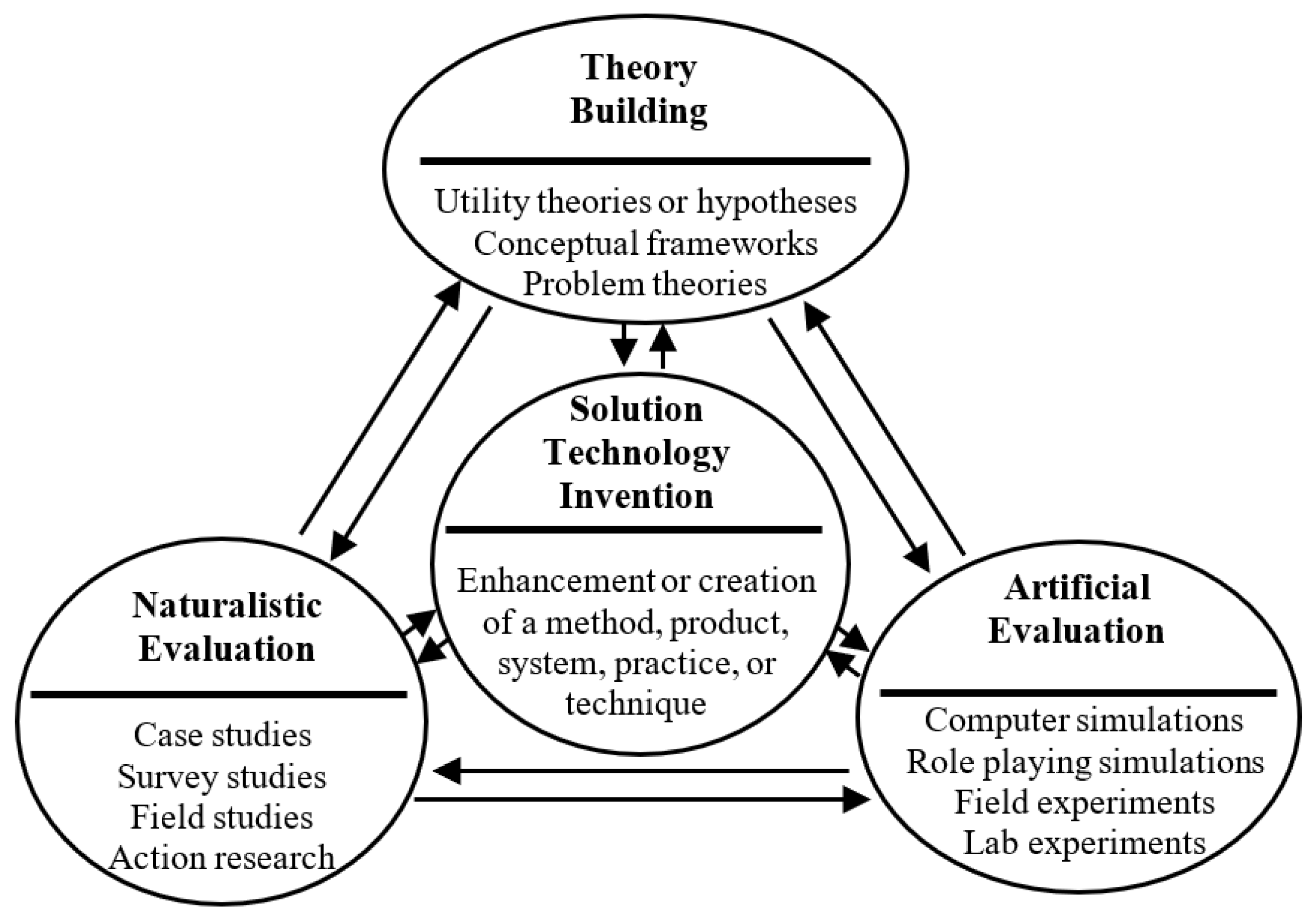

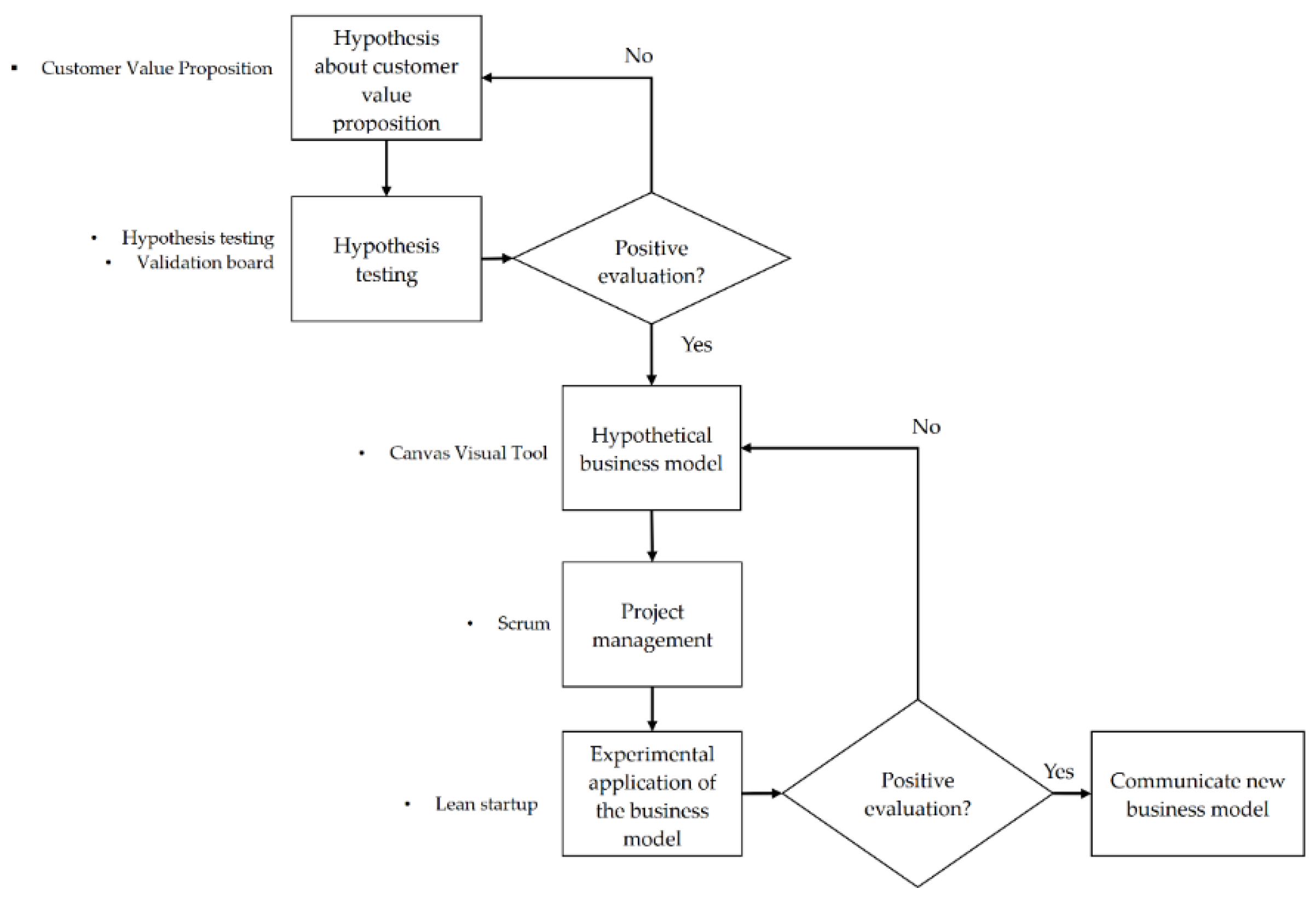


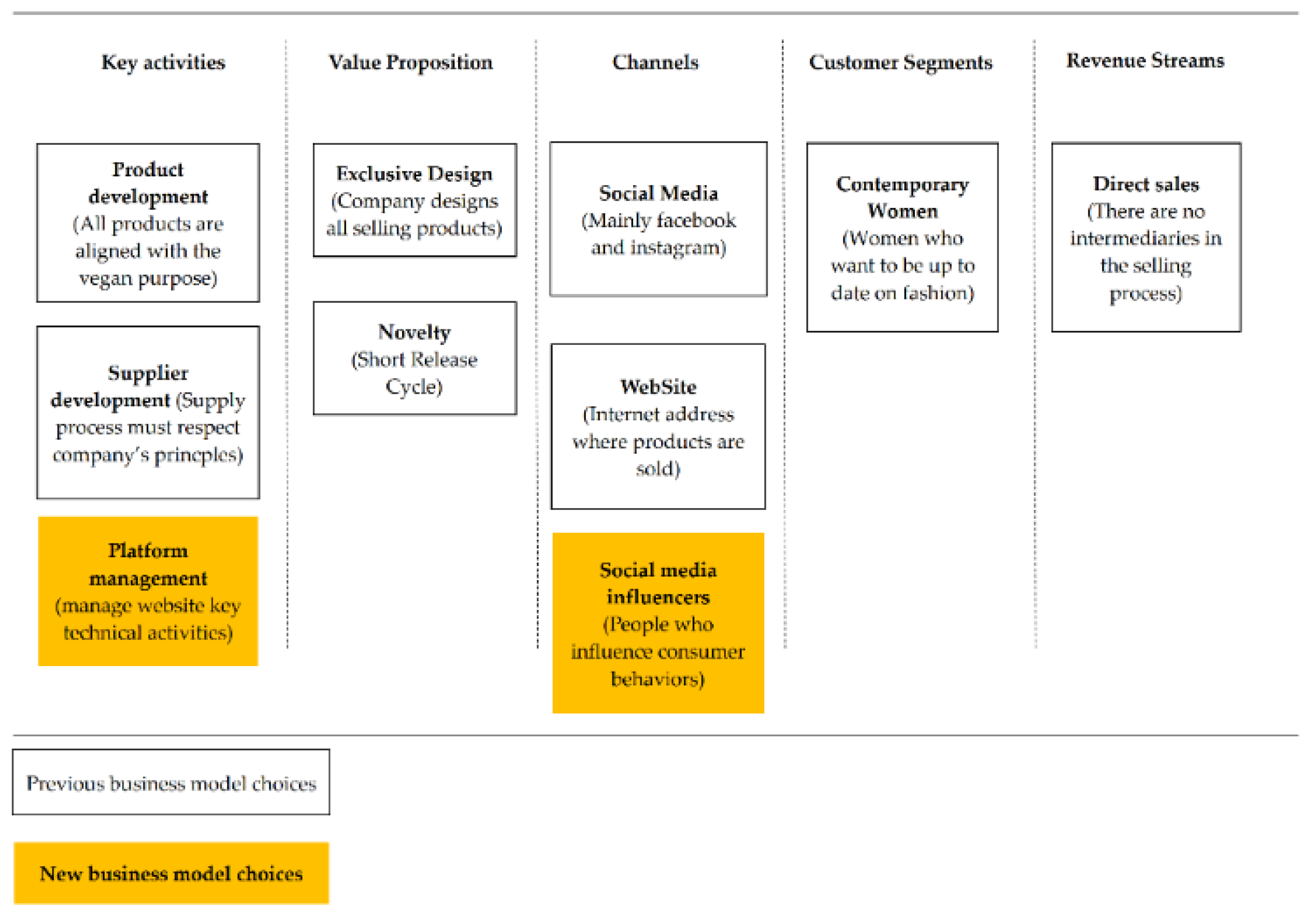
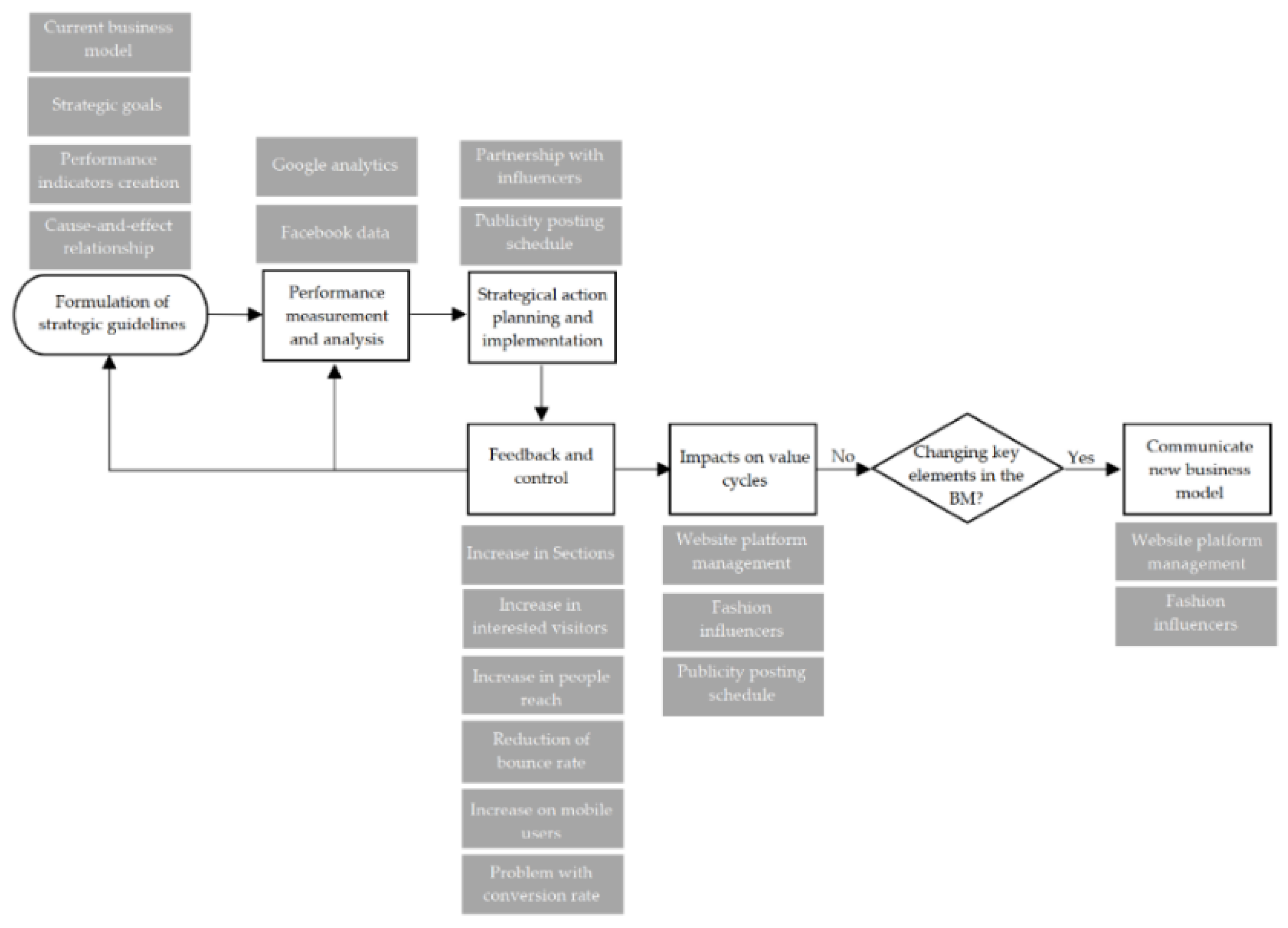
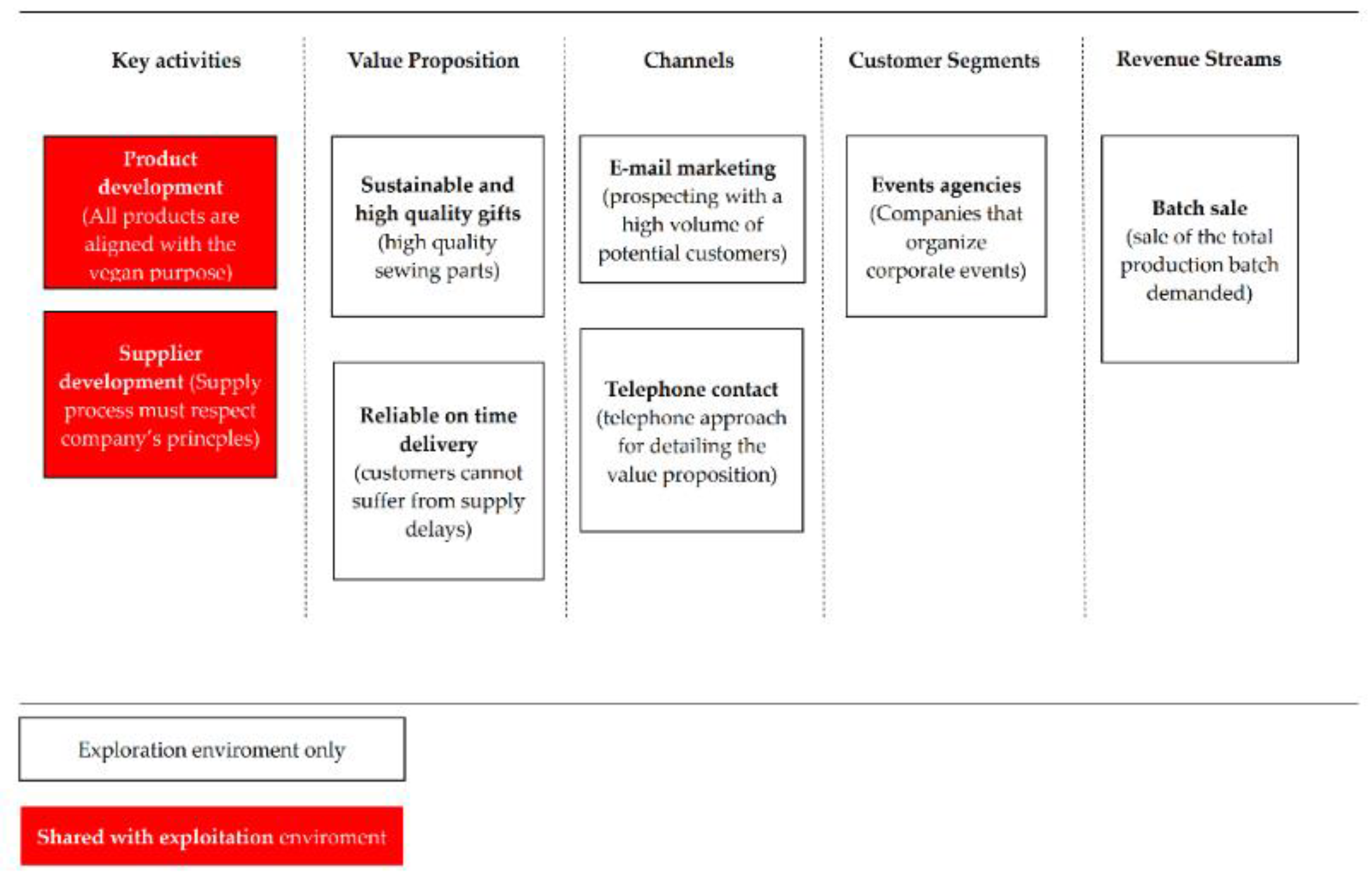
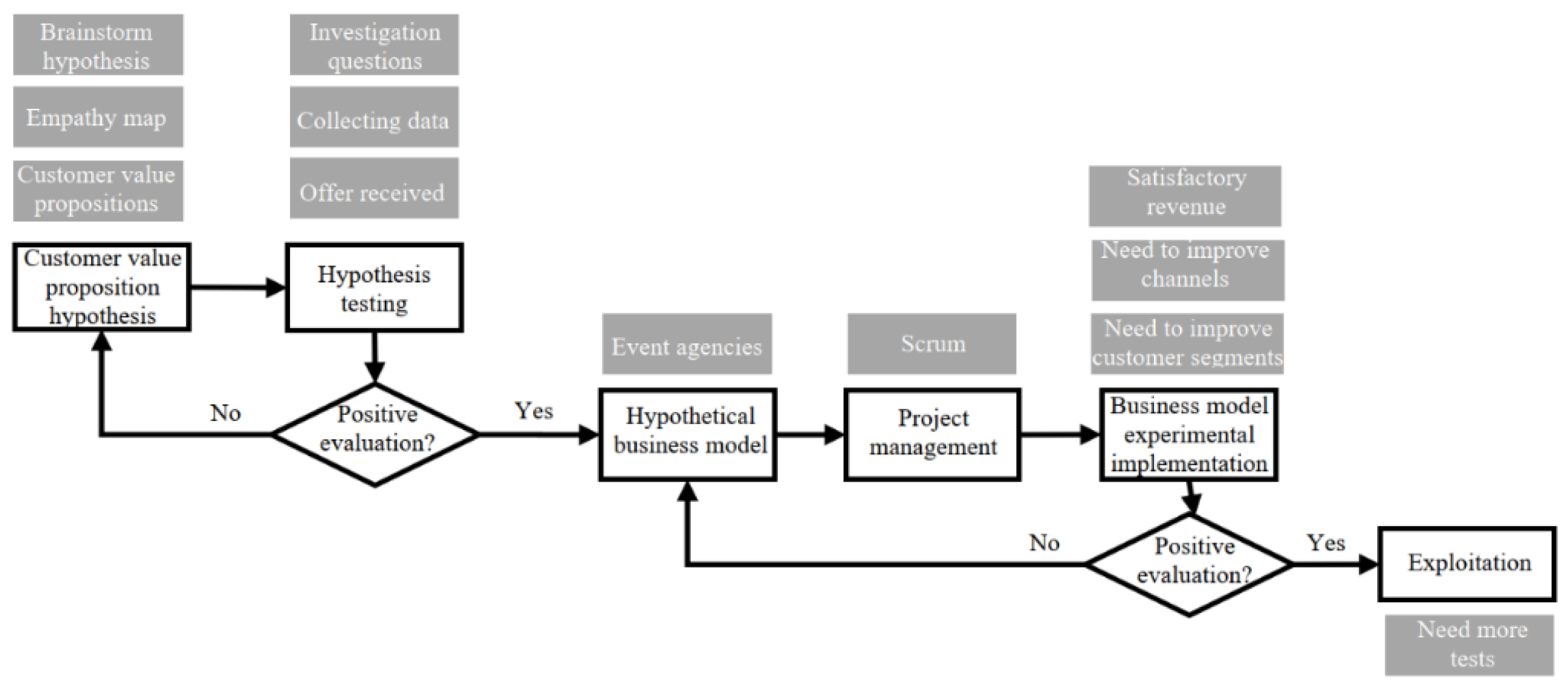

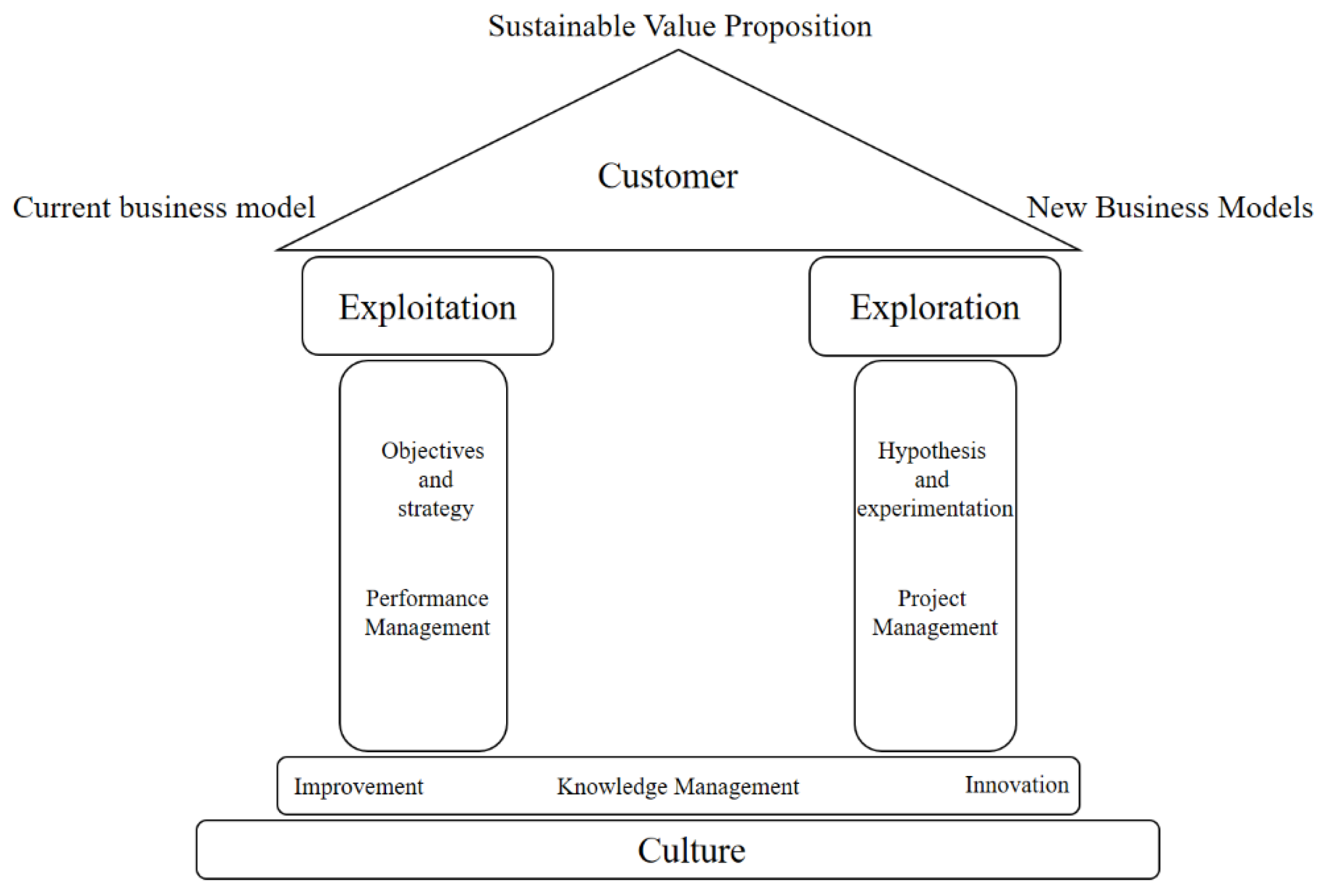
| Class of Problem | Artifacts |
|---|---|
| Production planning and control | Drum-Buffer-Rope [80]; Kanban [81]; CONWIP [82] |
| Cost measurement | Throughput Accounting [83]; Activity-based Costing [84]; Production effort units [85] |
| Process mapping | Value stream map [86]; Mapping by production function mechanism [87]; Architecture of integrated information systems ARIS [88] |
| Problem analysis and decision-making support | Thinking process [89]; Systems thinking and scenario planning [90]; Method for problem identification, analysis and solving [91] |
| Project management | Critical chain [92]; PERT/CPM |
| Data Source | Exploitation | Exploration | KM |
|---|---|---|---|
| Interviews | The exploitation environment focus was mainly to teach key selected tools and follow the designed process. Thus, interviews were used first to teach and pass knowledge to the company. Second, it was used to follow-up the usability, the practical results, the satisfaction and the capability to reach practical solutions. Finally, interviews were used to understand the creative process for BM improvements. | Interviews were conducted in the exploration environment to teach the practitioners the artifact and the associated tools. Then, subsequent interviews were conducted to evaluate the relationship between practitioners and the artifact’s usage, its potential outcomes and drawbacks. | Interviews were conducted to understand how the generated knowledge in each environment was being used by the company. The dynamics of the contextual ambidexterity was evaluated, to understand potential disruptions and negative effects on the company’s routines. |
| Documents | Documents were the key data source for the exploitation environment. We gathered data from the company’s ERP, the company’s strategic maps and balanced scorecard, from the company’s data analytics and the company’s BM evolution. The goal was to derive the evolution of the company’s BM and its performance. | We used documents such as the notes from telephone and e-mail contacts and BM design evolution through the process to understand its performance. The focus is to understand the BM creation process, as well as the fit to the designed artifact | |
| Observation | We observed day-to-day activities, how the artifact impacted the company and how was its application, also used to reduce informant bias from interviews. | We participated in the company exploration endeavors, to observe the contacts with the customer segments, and how the tools were used. | We participated in several meetings and routine activities of the company during the artifact’s implementation. We also observed the shift between activities in both environments to better understand the challenges and impacts of the contextual ambidexterity in managerial terms |
© 2020 by the authors. Licensee MDPI, Basel, Switzerland. This article is an open access article distributed under the terms and conditions of the Creative Commons Attribution (CC BY) license (http://creativecommons.org/licenses/by/4.0/).
Share and Cite
Minatogawa, V.; Franco, M.; Durán, O.; Quadros, R.; Holgado, M.; Batocchio, A. Carving out New Business Models in a Small Company through Contextual Ambidexterity: The Case of a Sustainable Company. Sustainability 2020, 12, 2337. https://doi.org/10.3390/su12062337
Minatogawa V, Franco M, Durán O, Quadros R, Holgado M, Batocchio A. Carving out New Business Models in a Small Company through Contextual Ambidexterity: The Case of a Sustainable Company. Sustainability. 2020; 12(6):2337. https://doi.org/10.3390/su12062337
Chicago/Turabian StyleMinatogawa, Vinicius, Matheus Franco, Orlando Durán, Ruy Quadros, Maria Holgado, and Antonio Batocchio. 2020. "Carving out New Business Models in a Small Company through Contextual Ambidexterity: The Case of a Sustainable Company" Sustainability 12, no. 6: 2337. https://doi.org/10.3390/su12062337
APA StyleMinatogawa, V., Franco, M., Durán, O., Quadros, R., Holgado, M., & Batocchio, A. (2020). Carving out New Business Models in a Small Company through Contextual Ambidexterity: The Case of a Sustainable Company. Sustainability, 12(6), 2337. https://doi.org/10.3390/su12062337







